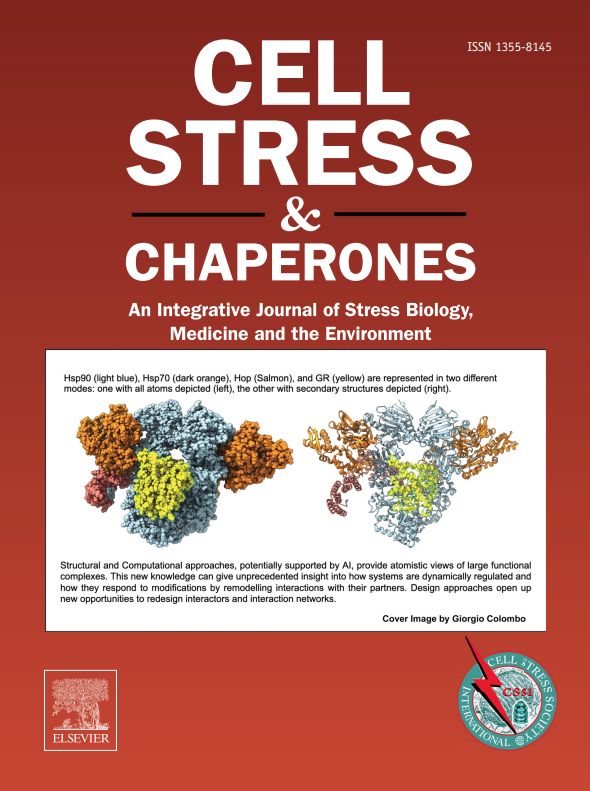Hypoxia- and mechanical stress–induced upregulation of mitochondrial HSP60 is associated with phenotypic switching of pulmonary arterial smooth muscle cells
IF 3.2
3区 生物学
Q3 CELL BIOLOGY
引用次数: 0
Abstract
Background
Switching from a contractile to a synthetic phenotype of pulmonary arterial smooth muscle cells (PASMCs) is known to play a crucial role in pulmonary arterial hypertension (PAH). We investigated how hypoxia and mechanical stress mediate the phenotypic switching of PASMCs.
Methods
Human PASMCs were used for experiments. Hypoxia treatment was done by culturing cells under 1% O₂. Mechanical stress was induced by loading cells to 50 mmHg hydrostatic pressure. We analyzed cell morphology, cell proliferation, phenotypic marker protein expression, cytokine release, and the activation of stress-related pathways at 24 h after treatment. Bulk and single-cell RNA-sequencing datasets were used to analyze heat shock protein family D member 1 (HSPD1) expression in PAH lungs and PASMCs. Heat shock protein 60 (HSP60) was knocked down in PASMCs by transfection of HSPD1-siRNA.
Results
Either hypoxia or mechanical stress alone induced the morphology change, increased cell proliferation, and promoted the phenotypic switching and inflammatory cytokines release of PASMCs. Interestingly, all those were dramatically enhanced under the combination of hypoxia and mechanical stress. Mechanistically, we found that the combination of hypoxia and mechanical stress not only significantly enhanced the mitochondrial HSP60 expression but also induced its partial redistribution to the cytosol. Bioinformatic analyses also confirmed the elevated HSPD1 expression in PAH lungs and PASMCs. HSP60 knockdown effectively attenuated the phenotypic switching of PASMCs induced by hypoxia and mechanical stress.
Conclusion
Hypoxia- and mechanical stress-induced upregulation of mitochondrial HSP60 is associated with phenotypic switching of PASMCs.
缺氧和机械应力诱导的线粒体HSP60上调与肺动脉平滑肌细胞的表型转换有关。
背景:众所周知,肺动脉平滑肌细胞(PASMCs)从收缩型向合成型的转变在肺动脉高压(PAH)中起着至关重要的作用。我们研究了缺氧和机械应力如何介导PASMCs的表型转换。方法:采用人pasmc进行实验。缺氧处理是在1% O₂下培养细胞。将细胞加载至50mmHg静水压力诱导机械应力。我们分析了治疗后24小时的细胞形态、细胞增殖、表型标记蛋白表达、细胞因子释放和应激相关通路的激活。使用大量和单细胞rna测序数据集分析热休克蛋白家族D成员1 (HSPD1)在PAH肺和pasmc中的表达。热休克蛋白60 (HSP60)通过转染HSPD1-siRNA在PASMCs中表达下调。结果:缺氧或机械应力均可诱导PASMCs形态学改变,细胞增殖增加,促进表型转换和炎性细胞因子释放。有趣的是,在缺氧和机械应力的联合作用下,所有这些都显著增强。在机制上,我们发现缺氧和机械应力的结合不仅显著增强了线粒体HSP60的表达,而且诱导其部分重新分布到细胞质中。生物信息学分析也证实了HSPD1在PAH肺和pasmc中的表达升高。HSP60基因敲低可有效减弱缺氧和机械应力诱导的PASMCs表型转换。结论:缺氧和机械应力诱导的线粒体HSP60上调与肺动脉平滑肌细胞的表型转换有关。
本文章由计算机程序翻译,如有差异,请以英文原文为准。
求助全文
约1分钟内获得全文
求助全文
来源期刊

Cell Stress & Chaperones
生物-细胞生物学
CiteScore
7.60
自引率
2.60%
发文量
59
审稿时长
6-12 weeks
期刊介绍:
Cell Stress and Chaperones is an integrative journal that bridges the gap between laboratory model systems and natural populations. The journal captures the eclectic spirit of the cellular stress response field in a single, concentrated source of current information. Major emphasis is placed on the effects of climate change on individual species in the natural environment and their capacity to adapt. This emphasis expands our focus on stress biology and medicine by linking climate change effects to research on cellular stress responses of animals, micro-organisms and plants.
 求助内容:
求助内容: 应助结果提醒方式:
应助结果提醒方式:


